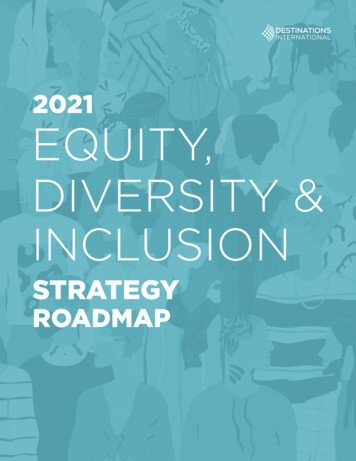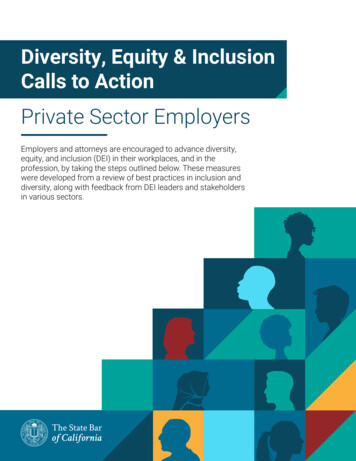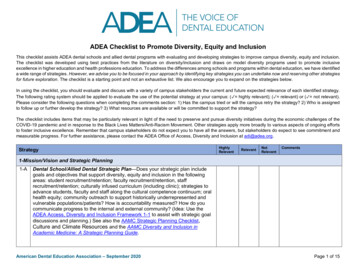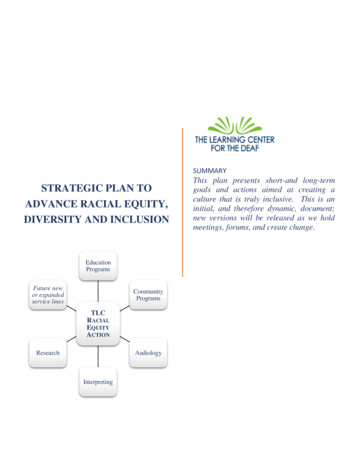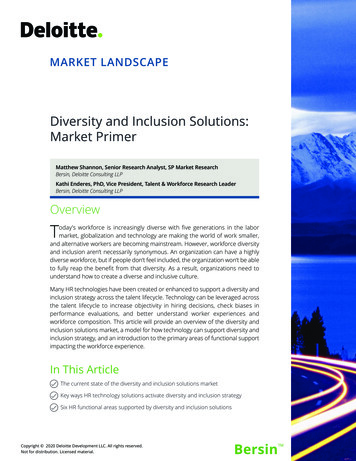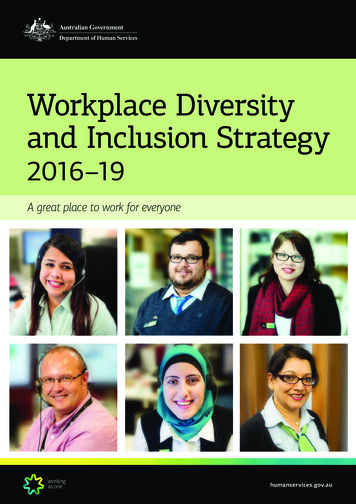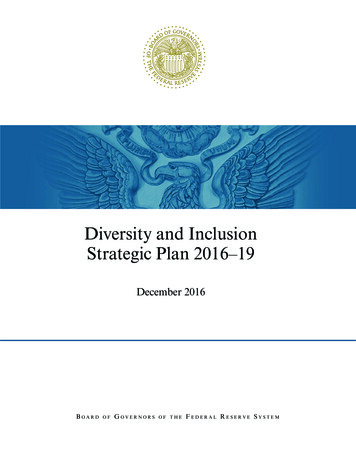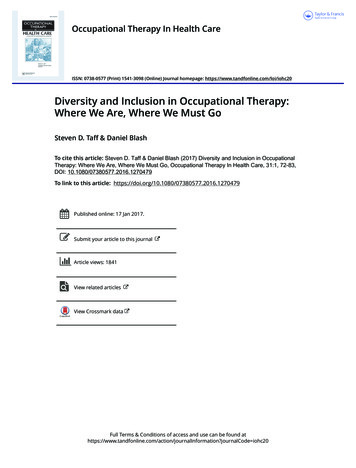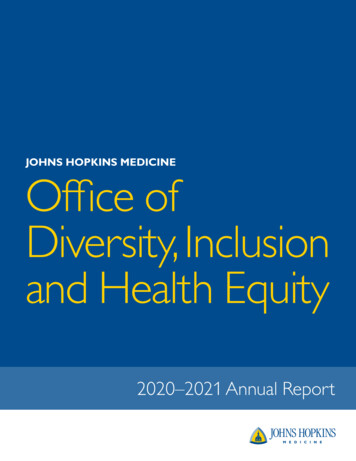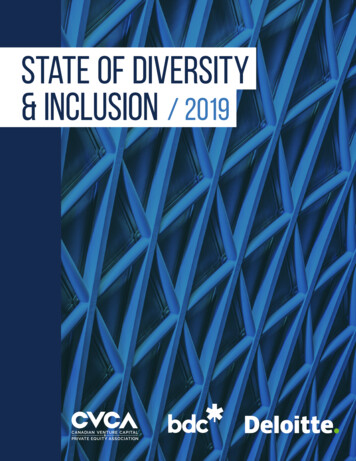
Transcription
State Of Diversity& Inclusion / 2019
table ofcontents3 Introduction4 The Business Case5 CVCA Diversity and Inclusion Mandate6 “WHERE’S THE DIAL NOW?” REPORT7 WOMEN IN VENTURE REPORT8 Summary of Findings from our Members15 What the CVCA Pledges to Do16 What We Encourage CVCA Members to DoCVCA STATE OF DIVERSITY & INCLUSION 20192
INTRODUCTIONThe Canadian Venture Capital and Private EquityAssociation (CVCA) and BDC Capital are pleasedto present this human capital benchmark report ondiversity and inclusion (D&I). The report is based onfindings from a survey conducted by Deloitte andcommissioned by the Canadian Venture Capitaland Private Equity Association (CVCA), and BDCCapital, the Canadian Private Equity and VentureCapital – State Of Diversity & Inclusion 2019 reportprovides a snapshot of the current state of diversityand inclusion within the Canadian private equity (PE)and venture capital (VC) sectors and establishesbaseline data based on CVCA membershipresponses to the survey to measure the sector’sprogress over the coming years.This benchmarking report identifies a number ofopportunities for improvement and meaningfulaction items that CVCA members can take toembed D&I best practices into their organizations.The business case is clear. Diversity and inclusion drives performance and, as an industry,we want to be at the forefront of driving this change not only in private capital but also for thebroader innovation ecosystem.Whitney RockleyCo-founder and Managing Partner of McRock Capital and Co-chair of CVCA Diversity and Inclusion committeeAt BDC, we recognize that diversity and inclusion practices are not only the right thing to do,it makes good business sense. That’s why diversity and inclusion are part of our businessstrategy. We want our organization as well as the ones we work with, to reflect Canada’sincreasingly diverse workforce and business community.Jérôme NyczExecutive Vice President, BDC CapitalCVCA STATE OF DIVERSITY & INCLUSION 20193
the businesscaseOver the last 30 years, business schools,management consulting firms, and leadingcorporations have clearly demonstrated thateffective management of workplace D&I is linkedto improvement in organizational performance,effectiveness, profitability, and revenue generation.The evidence also indicates that diversity in a noninclusive workplace does not lead to success. A2013 Deloitte report highlighted that employees thatfelt highly included were 67% more engaged whilestaff with high levels of diversity and low levels ofinclusion were only 20% more engaged. Firms thatfocus on both diversity and inclusion experience alift of more than 101% in employee engagement.1A recent Harvard Business School reportdemonstrated that diversity in VC firms notonly spawns greater creativity from alternativeviewpoints, but also improves financial performance.“Having at least one woman in a VC fund improvedperformance by approximately 10 percent. Thatis, while the median venture capital fund return isaround 14 to 15 percent, funds with a female partnerreturned 16 to 17 percent. Moreover, having womenas partners increased the percentage of successfulstartups supported by those firms—that eitherwent public or sold for more than their totalCVCA STATE OF DIVERSITY & INCLUSION 2019capital investment—from about 28 percent to about31 percent.”2Finally, McKinsey has published data twice inthe last six years that also links the productivityand profitability gain of diversity. According totheir 2014 data “companies in the top quartile forgender diversity on their executive teams were 15percent more likely to experience above-averageprofitability than companies in the fourth quartile.”According to their 2017 data set “this number roseto 21 percent and continued to be statisticallysignificant.”3In summary, inclusive diversity is not only the rightthing to do, it is the financially strategic thing to do.1 Source: nclusion-soup-0513.pdf2 Source: nclusion-soup-0513.pdf3 Source: zation/ourinsights/delivering-through-diversity4
CVCA Diversity& Inclusion MandateThe CVCA is committed to improving D&I in the Canadian privatecapital market. The organization recognizes its influence and itsresponsibility to support the leadership of its members in moving theneedle on D&I.The CVCA believes that diversity refers to a range of human differenceswhich include, but are not limited to, visible dimensions such as race,ethnicity, gender, as well as invisible dimensions such as religion,political beliefs, and sexual orientation. Diversity also recognizes humandifferences in personality and organizational characteristics.Inclusion refers to creating an environment in which people feel involved,respected, valued, and connected, and to which individuals bring theirauthentic selves (ideas, backgrounds, and perspectives) to their work withcolleagues, entrepreneurs, investors, and the broader community.Since 2017, under the stewardship of the CVCA Diversity and InclusionCommittee’s co-chairs Whitney Rockley, co-founder and ManagingPartner, McRock Capital, and Sophie Gupta, Principal, Operations,Yaletown Partners, the CVCA has been pursuing a program-levelapproach to improve D&I in the venture capital and private equitycommunity to foster greater diversity of thought.The program includes these 6 streams:1.University Reach Outs: Over 1,000 students have attended presentationsdelivered by leaders in our VC and PE firms.2. Best Practices for an Inclusive Workplace: After researching options, theCVCA endorsed the ILPA Code of Conduct. The sub-committee is currentlyexploring tools that can make it easier for private capital organizations tofacilitate employee inclusiveness. [see sidebar]3. Human Capital Benchmark: This report establishes a benchmark from whichthe CVCA can successfully measure subsequent change.4. Showcasing Success: Since 2017, the CVCA has published over 50 storieson its publication, CVCA Central, highlighting how members are successfullyintegrating and benefiting from D&I.5. Industry Events: The CVCA intentionally builds D&I into the design of itspanels/events to ensure that they reflect the diversity in Canadian society.6. D&I Resource Library: CVCA has compiled D&I tools, mentorship programs,reports, and articles. This resource library is available in a central location onthe CVCA website.CVCA’s Diversity and Inclusion mandate is to provide tools to membercompanies with the goal of increasing the number of women and otherunderrepresented groups in the private capital industry. Since early 2017, theCVCA has worked with partners on two important benchmarking reports.Promoting thesustainability of ahealthy, inclusive &diverse Canadian privatecapital industryIn the fall of 2016, Manpreet Kaur attendedher first CVCA event. Held in Toronto bythe Young Professionals Committee (YPC),the networking event’s guest speaker wasJanet Bannister: a partner at Real Venturesand the founder of Kijiji Canada.Up until then Kaur, a neuroscience graduate, had only read about the venturecapital industry.Bannister shared her story about expanding Kijiji into Canada from Silicon Valleyand how she became one of few femalepartners at a venture capital firm.The talk inspired Kaur to take the nextsteps in her career.“It became clear to me.that there wasno one path into VC, nor was thereone profile that necessarily fit the bill.[I learned that] many experiences andskills could translate well into a career inVC,” she says.Today, Kaur is an investment analyst atTeralys Capital in Montreal, Que. TeralysCapital is a venture capital fund of fundswith 2B in AUM, the largest innovation-focused investor in Canada.Kaur says she had no business being inbusiness. After finishing her undergraduate degree at the University of Toronto,she decided she didn’t want to pursuemedicine or a career in academia. Insteadshe landed in the oil and gas industry andrealized she liked working with investors.“What I knew about private equity andventure capital was largely based onactivity in the United States,” says Kaur.Continued on page 6CVCA STATE OF DIVERSITY & INCLUSION 20195
“WHERE’S THE DIALNOW?” REPORT“Where’s The Dial Now?”4 is a benchmark report released in 2017, that examined the current state of women inthe tech and innovation community in Canada. Key findings were:Only 5% of Canadiantech companieshave a female founder. Whencompanies with male and femaleco-founders are factored in, thepercentage of tech companiesfounded by women increases to 13%Only 5%of Canadiantech companieshave a female CEOOn average,53% oftech companieshave no women executivesonly 8%of directorsare women,while 73% of boardshave no women at allWomenmake up 13%of the average techcompany’s executive teamApproximately30% of Canadianventure capitalfirmshave a female partner4 Co-authored by #movethedial, PwC Canada and MaRS, and powered by Ceridian, Canadian Venture Capital and Private Equity Association (CVCA),BDC Capital (BDC) and Osler, Hoskin & Harcourt LLPContinued from page 5“When I started to dig into what washappening within Canada, I came acrossthe CVCA annual reports, which helped putthings into perspective for me and understand the key players and structure of thelocal market.”Last year Whitney Rockley, co-founder andpartner of the venture capital firm McRockCapital, hosted a roundtable for womenin Kaur’s MBA class as part of a universityoutreach program launched by the CVCA.Kaur says having senior female investors in the industry is essential for earlycareer women:“I really do believe that you can’t be whatyou can’t see.”She also sees the value in hiring not onlymore women, but people from diversebackgrounds. Her parents are immigrantsfrom India who started businesses inQuebec with very little money or knowledge of the French language.CVCA STATE OF DIVERSITY & INCLUSION 2019“Growing up I never thought twice to myselfthat I’m a female, or I’m a visible minority. Iwas just me,” she says.means, was supposed to be here. I’m not afinance guru; I didn’t spend years in investment banking or consulting,” says Kaur.“By having diverse investors, that tricklesdown to the entrepreneur level, and givesthem a foothold It allows investors to relateto that story, I think, a little bit more.”“You definitely shouldn’t let your background deter you. There’s nothing in thisworld that you can’t learn or where the information isn’t accessible. If you’re willing,you’ll figure it out.”At another networking event, Kaur met anassociate from Teralys Capital who wasalso a member of the CVCA Diversity andInclusion committee. Teralys had recently reformed their recruitment process andkept the application period open until theyachieved a parity of diverse and non-diverse candidates.“Throughout the entire interview process Iwasn’t made to feel as though I was a D&Icandidate, and that I was just there becausethat representation was needed on theirend, which to me personally meant a lot”says Kaur.After 9 months at Teralys, Kaur reflects onher journey, past and to come: “I by noKaur has some final advice for aspiringventure capitalists:Cold-calling is your best friendI get [a lot of] copy-pasted emails. Don’tdo that. Find a point of commonality, finda reason to want to talk to this individual,and I’m more than sure you’ll get some formof response.Attend CVCA eventsIf this is an industry that you’re interestedin, the exposure and network that you getby attending these events [is something] Idon’t think you can get elsewhere.6
WOMEN IN VENTUREREPORTWith data from over 300 VC firms and corporate venture arms across Canada and the USA, this reportpainted a clearer picture of the state of gender. The results give institutions and individuals the informationneeded to understand the current status and take action. The Canadian Private Equity and Venture Capital:State of Diversity & Inclusion 2019 report aims to extend these pioneering reports to other diverse groupsnot captured previously.11.8% ofManaging Partnersat funds across Canadaare womenCVCA STATE OF DIVERSITY & INCLUSION 2019 4.6 billioninvested in active Canadianfunds with no women partnersFirms with 1 or more women partnersraise funds that are, on average,66% the sizeof those raisedby firms with all male partners7
Summary of Findingsfrom our MembersRepresentation of Women in Canadian Private Capital91 member firms out of 275 participated in the survey during the period between January 10, 2019 andFebruary 1, 2019. This included 23 out of 60 PE firms and 36 out of 84 VC firms.Of those that participated, 23 PE firms had 145 partners of which only 17 (12%) were female and 36 VC firmshad 132 partners of which 14 (11%) were female.5The results of this report, in addition to the data uncovered in the “Where’s the Dial Now?” and “Womenin Venture” reports, clearly show the need to increase representation of women in senior ranks of privatecapital investment firms.128MALE 88%PARTNERSPRIVATEEQUITY1712% FEMALEPARTNERS118MALE 89%PARTNERSVENTURECAPITAL11%14FEMALEPARTNERSThe private capital industry trails the Canadian banking and legal professions which have 38% and 25% oftheir management positions held by women.BENCHMARKSMALEPARTNERS 62%BANKINGFEMALE38% PARTNERSLEGALFEMALEMALEPARTNERS 75% PROFESSION 25% PARTNERS5 Source: Approximated figures based on firm websitesCVCA STATE OF DIVERSITY & INCLUSION 20198
There is opportunity in the private capital industry to promote more women into partner roles because thefemale talent pipeline is strong, as can be seen in the below exhibits.8 out of the 36 VC firms that participated have more than 50% of their entry level/junior and 5 out of the 36have more than 50% of their non-partner managers who are women.VENTURE CAPITAL8526867Percentage 50%of firms’employees who30-50%self-identify asLess than 30%women1515None2268ENTRY-LEVEL/JUNIOR EMPLOYEESNON-PARTNER MANAGERSPARTNERS363536NUMBER OF FIRMS WHO RESPONDEDOf the 23 PE firms, 6 have more than 30% of their entry level/junior employees and 4 out of the 23 havemore than 30% of their non-partner managers who are women.PRIVATE EQUITY152216Percentage 50%of firms’employees who30-50%self-identify asLess than 30%women10131475ENTRY-LEVEL/JUNIOR EMPLOYEESNON-PARTNER MANAGERSPARTNERS232223NoneNUMBER OF FIRMS WHO RESPONDEDCVCA STATE OF DIVERSITY & INCLUSION 201929
Representation of Visible Minoritiesin Canadian Private CapitalOf the 145 partners at PE firms only 8 (6%) were visible minorities. Of the 132 partners at VC firmsonly 24 (18%) were visible minorities.6137CAUCASIANOR WHITE 108CAUCASIANOR WHITE 82%PARTNERSVENTURECAPITAL24VISIBLE18% MINORITYPARTNERSPE firms trails the Canadian banking and legal professions which have visible minorities holding 15% and9% respectively of their senior management positions. However, VC firms have a higher percentage ofpartners who are visible minorities compared with banking and legal professions.BENCHMARKSCAUCASIANOR WHITE 85%PARTNERSBANKINGVISIBLE15% MINORITYPARTNERSCAUCASIANOR WHITEPARTNERS91%LEGALPROFESSIONVISIBLE9% MINORITYPARTNERS6 Source: Approximated figures based on firm websitesDIVERSITY ANDINCLUSION: A MAINPRIORITY AND A MINDSETAt Quark Venture LP, diversity and inclusionis not only a main priority; it’s a mindset,according to the firm’s CEO & PartnerKarimah Es Sabar.“We live it, we practice it and we have aculture of diversity and inclusion that is justthere—which attracts people to us,” saysEs Sabar.Research has shown that women-ledCVCA STATE OF DIVERSITY & INCLUSION 2019companies outperform and have a higherrate of employee engagement. Women inventure capital are also more likely to investin female entrepreneurs.Es Sabar believes diversity isn’t just aboutincreasing the number of women in theindustry; it’s about hiring people basedon their skills and abilities, no matter theirbackground. She says companies shouldbe diligent in actively seeking out peoplewho are the best fit, rather than fillingquotas.“You need to be open to giving opportunityto people who you’re not typically hiring,”she says.Es Sabar has spent the last 30 yearsbuilding diverse teams at companies likeSanofi Pasteur, previously Pasteur MerieuxConnaught, and the Centre for Drug andResearch Development before becomingCEO and a partner at Quark Venture.While more than half of Quark Venture’semployees are women, they are alsoculturally diverse. More than 50 per centare visible y in health technology and hasoffices in Boston, Berkeley, Hong Kong andChengdu, China. Es Sabar says innovationis about challenging the status quo andrequires diverse thoughts and perspectives.Continued on page 1110
What bodes well for the future is that the pipeline of visible minority talent is strong. Of the 36 VCfirms, 9 had more than 30% of their entry-level/junior employees and non-manager partners whowere visible minorities.VENTURE CAPITALPercentageof firms’employeeswho considerthemselvesvisibleminorities 50%75241430-50%25872021ENTRY-LEVEL/JUNIOR EMPLOYEESNON-PARTNER MANAGERSPARTNERS363636Less than 30%13NoneNUMBER OF FIRMS WHO RESPONDEDOf the 23 PE firms, 7 had more than 30% of their entry-level/junior employees who were visibleminorities. A smaller number, 2 out of the 23, had more than 30% of their non-partner managerswho were visible minorities.PRIVATE EQUITY34Percentageof firms’employeeswho considerthemselvesvisibleminorities 50%111781030-50%1512Less than 30%6NoneENTRY-LEVEL/JUNIOR EMPLOYEESNON-PARTNER MANAGERSPARTNERS232223NUMBER OF FIRMS WHO RESPONDEDContinued from page 10It has been proven that a diverse workforceimproves productivity and performance.“Diversity inherently brings differentperspectives to solving a problem,”Es Sabar says.“And I find that my team is much morepeople-savvy and really have strong humanskills which are vital for the business thatwe’re in I love it because [they] really thinkoutside the box and have a completelyfresh approach.”Quark Venture looks at each project on itsown merit. If a project doesn’t suit the firm’sportfolio strategy, but they find it particularlyinnovative or ground-breaking or really likeCVCA STATE OF DIVERSITY & INCLUSION 2019the team who are working on it, “we finda way to invest,” says Es Sabar. The firmalso proactively provides expertise to theirportfolio companies where appropriate.“Our approaches to investment have beenunusual, and we found that others havestarted to follow our trend.”Creating a more inclusive workplace isa cultural shift that starts at the top, shesays. The more diverse the thoughts,approaches, methodologies and businesspractices a company has in place, themore value is created.Management should seek out multi-genderand multi-cultural candidates during theinterview process and consider partneringwith organizations who help underservedpopulations like new immigrants. “Someare highly educated and skilled, and wereally need to utilize these skills,” saysEs Sabar.Companies also need to be open-mindedand understand that hiring diversecandidates is just the start. You can haveall the policies and procedures you want,”she says. “But making those people feelvalued and their opinions included isimportant; inclusiveness is all about theculture of the organization.”11
Representation of Indigenous, LGBTQ & Personswith Disabilities in Canadian Private CapitalOf the PE and VC firms surveyed, compared to representation of women and visible minorities, there is aclear opportunity to boost representation across these groups. The table below illustrates the percentage offirms’ employees belonging to these groups who have self-identified:23 PE firms36 VC firmsINDIG EN O USI ND I GENOUSLESSTHAN 1 0 %N ONELESSTHAN 10%NONE10-20%LG BTQ 1 -1 0%LGBTQ N ONE1- 10%NONE10-3 0%PE RS O NS W ITH DI SA BI LI TI ESPER SONS W I TH D I SABI L I TI ES1 -1 0%1- 10%N ONENONE10-3 0%MORETHAN 50%CVCA STATE OF DIVERSITY & INCLUSION 201912
inclusive practices at firmsEmployee engagement and/or D&I surveys are a common tool that organizations can use to measure andtrack employee engagement and inclusion. Among PE and VC firm respondents, only a small percentage (17%and 11%, respectively) conduct employee engagement and/or D&I surveys. Of the firms who conduct surveys,the average level of measured employee engagement for PE and VC firms is 89% and 90%, respectively.P E F I R M S T H AT C O N D U C T A NEM P LOY E E E N GAG E M E N T A N D / O R D & I S U RV E YVC F I R M S T H AT C O N D U C T A NE M P LOY E E E N GAG E M E N T A N D / O R D & I S U RVEYYES17%Y ES83%NO11%89%NOAV ERAG E LE VE L OF E N GAGE ME N TAND INCLU S ION ME AS U RE D BY S U RVE YAV ER AG E L EV EL O F EN GAG EM EN TA N D I N C LUS I O N M EAS UR ED BY S URV EY89%90%Firms with stated commitments to D&I are more likely to have diverse and inclusive organizations. Among PEfirm respondents, only 22% had stated commitments to D&I, with 39% of respondents answering ‘Unknown’.The VC firms have higher rates of stated commitments to D&I with 53% responding ‘Yes.’P E F I R MS WI T H STAT E DC O M M I T M E N TS TO D & IVC F I R M S W I T H STAT E DC O M M I T M E N TS TO D & IY ESUNK N OW NU NKNOWN11%22%39%53%36%39%TOTAL P E FIRMS23CVCA STATE OF DIVERSITY & INCLUSION 2019YESNONOTOTA L VC F I R M S3613
Survey respondents were asked to state if their firms have policies and/or practices in place to ensure allemployees are treated fairly. PE and VC firms saw 65% and 83% responding ‘Yes’ to the question. Those whoreported having practices in place listed inclusive leadership training and inclusive talent systems which areknown to have higher impact than leading with employee resource groups or simply hiring more women.These numbers represent a good news story as firms appear to be laying the foundations for D&I.VC F I R M S W I T H P O L I C I E SA N D / O R P R AC T I C E S I N P L ACEP E F I R M S W I T H P O LI C I E SA N D / O R P R AC T I C E S I N P L AC EU NKNOWNUNK N OW NNO22%13%NO65%83%Y ESCVCA STATE OF DIVERSITY & INCLUSION 20199%8%YES14
What the CVCAPledges to DoTake A Leadership RoleThe CVCA will educate and inform its membership and stakeholders ofthe benefits of D&I through CVCA events and CVCA’s publications.Creating Opportunities for MembersThe CVCA will create education opportunities for its members inexisting and newly created programs. These programs will include theCanadian Private Capital Investment School.Showcasing Success in the IndustryThe CVCA will continue to shine a spotlight on those in ourmembership that have and continue to make positive changes in theirorganizations. The CVCA will leverage its industry publication (CVCACentral) and CVCA events to share media opportunities with thesechampions as they arise.Continued Support for Inclusive Industry ProgramsThe CVCA will continue to advocate for and support programs thatpromote a diverse private capital ecosystem. The CVCA has been asupporter of similar programs in the past, including the Venture CapitalCatalyst Initiative (VCCI) which has had dedicated streams focused onunderrepresented groups including women, diverse fund managementteams, entrepreneurs, and emerging sectors.“Diversity is essential to make a lasting impact on the futureof innovation in Canada. Diversity in leadership is proven tocreate more value for investors, more value for consumers,and support economic growth. By investing in strongteams and companies that lead by example, we acceleratethe growth of their business, drive competitiveness, andultimately create large companies that spur a new cultureof diversity and inclusion that sits at the foundation for anygood business culture. Over the past few years, there hasbeen a ground swell of support for change and we areheading in the right direction but there is still much moreto be done.”Michelle ScarboroughMaking a lastingimpact for womenin tech in CanadaResearch proves diversity makes good businesssense. BDC saw an opportunity to take a bold stepby investing in women specifically in the tech sector where women-led companies are under-funded and under-represented in Canada.BDC set out to change that with the Women inTechnology Venture Fund (WIT). At 200 million, itis the world’s largest venture fund investing solelyin women-led technology companies. To set theright focus for the fund, we consulted more than200 entrepreneurs and investors.Based on that research, WIT Fund was given a dualmandate to deliver a return on its investment andmake a lasting impact on the Canadian tech ecosystem. Leading by example so other funds follow.The majority of the fund’s capital is used to investdirectly in women-led tech companies (seed to Series A & B) who bring together the right technology,team and resources to create companies that transform or disrupt today’s markets. WIT has the fortunate position to provide patient capital to supportthe women in its portfolio companies as they growfrom seed to scale and keep enough capital formultiple investment rounds to help them reach theirfull potential. These are strong, scalable, revenuegenerating companies who want to grow quickly.Most importantly, they are women led, meaningthey have a female founder, co-founder, CEO orexecutive driving the direction of the business (whohas been in her role for at least one year).“Our mandate is to support and grow great womenleaders in tech and in venture, and lead by example so other funds follow,” said Michelle Scarborough, Managing Director, Strategic Investments,BDC Capital. “In the past year, we reviewed morethan 1,000 women-led tech companies. What it reinforces to me is that the number of women choosing entrepreneurship in technology and innovationis growing in Canada and we are just seeing thebeginning of women playing strong leadershiproles in tech enterprise.”In addition to direct investment, the fund works withpartners to foster a robust network to support andencourage women in technology and investmentroles that does not exist today. In the past year thefund has hosted a trade mission to China, launcheda scholarship for a female investor in a venture capital firm to attend the Kauffman Fellows Program,introduced a Women in Tech Bootcamp, referredhundreds of companies to other capital opportunities, established new partnerships and hosted dozens of workshops and networking events to connect women in tech and women investors. At thesame time, many funds across Canada are supporting diversity by helping to grow the ecosystem andmaking bold moves to grow the next generation ofleaders in the asset class and in their portfolios.As of March 2019, WIT Fund has already investedin 25 amazing Canadian, women-led tech companies. In addition, BDC has made a commitmentto support women entrepreneurs and will provide 1.4 billion in financing for women-owned businesses by 2021.Managing Director, Strategic Investments, BDC CapitalCVCA STATE OF DIVERSITY & INCLUSION 201915
What the CVCAEncourages itsMembers to doThe CVCA encourages all members to review their practices andpolicies to ensure the career success of their employees. In doingso, the skills and energy of the total workforce can be harnessedeffectively for the good of the industry to better reflect Canadiansociety. The best manner to achieve this is through a strategy thatintegrates the following eight facets7:VISION &S TR ATE GYA shared language,compelling story androadmap for changeLE A D E R S H I PCommitted, capableand accountableleadersSPECIALSPROGRAMSG OV E R N A N C EInterventions targetedat specific groups (e.g.careers)BRANDINGCommunication,partnerships andactions that re-inforcecommitment8 FAC ETSTO AD&I STR ATE GYTH AT WO R KBUSINESSSYSTEMS &INFRASTRUCTUREIntegration of diversityand inclusion into business processes (e.g. innovation) and infrastructure (e.g. workplacedesign)Senior level oversightand appropriateresourcingMEASUREMENTSINCLUSIVETALE NTSYSTE MSData and metricsto measureperformanceand progressInclusive talentmanagement toattract, grow andretain diversetalentTake Meaningful Action:Develop onboarding and engagement strategies Access diverse talent pools by posting jobs on the CVCA job board Pursue new recruitment strategies and targets such as diverse andinclusive organizations, conferences, and job fairs Pursue retention strategies The CVCA D&I Best Practices for an Inclusive Workplacesubcommittee is currently researching various tools being used in theindustry and will make its recommendations later in 2019 Volunteer a spokesperson to speak on industry panels to Canadianuniversity students to increase awareness about career paths inprivate capital.DIVERSE TEAMS SUCCESSFULPARTNERSHIPS AND NEWBUSINESS OPPORTUNITIESAt InstarAGF Asset Management Inc., respect for people, communities and the environment play a critical role in the company’s success. The five-year-old firm investsin essential infrastructure assets acrossNorth America, including renewable energy, transportation, logistics and urbanconnectivity, aiming to deliver attractivereturns to investors while fostering socialvalue in the communities where its businesses operate.“Infrastructure investing is fundamentallyabout empowering people and helping tocreate economic opportunity and a better quality of life,” says Senior Vice President Sarah Borg-Olivier. “Having a diverseteam helps us to partner more effectivelywith our portfolio company executives andthe communities our assets serve.”According to Borg-Olivier, building diversity into the corporate culture starts atthe ground level, including seeking outpotential employees that offer new viewpoints and experiences, and bring newstrengths to its team. Nearly 60 per centof InstarAGF’s growing team are womenor visible minor
Capital - State Of Diversity & Inclusion 2019 report provides a snapshot of the current state of diversity and inclusion within the Canadian private equity (PE) and venture capital (VC) sectors and establishes baseline data based on CVCA membership responses to the survey to measure the sector's progress over the coming years.


